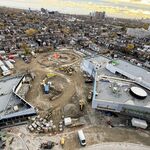doady
Senior Member
I always though Toronto was behind the times in transit. Isn't that basically why the streetcars survived after all?
I think Toronto could at least look to the 905 and adopt time-based fares. As for zone fares: Toronto is not a regional system, so why should it have zone fares? Integrate with 905, and then we can talk about zone fares.
And I can't believe that someone would call the Spadina line a "white elephant". How much more crowded would the Yonge Line be without it? Why is there DRL proposed?
What is the ridership of University-Spadina line anyways? According the station ridership statistics, the University-Spadina section accounts for 35.7% of ridership of the YUS line (not including Union), so around 260,000 riders per weekday.
No wonder Toronto is behind the times. A subway line with 260,000 riders per weekday providing relief to another line is a "white elephant", so nothing gets done, because nothing is good enough for Toronto's high standards. kEiThZ's post is representative of everything that wrong with transit in Toronto today.
I think Toronto could at least look to the 905 and adopt time-based fares. As for zone fares: Toronto is not a regional system, so why should it have zone fares? Integrate with 905, and then we can talk about zone fares.
And I can't believe that someone would call the Spadina line a "white elephant". How much more crowded would the Yonge Line be without it? Why is there DRL proposed?
What is the ridership of University-Spadina line anyways? According the station ridership statistics, the University-Spadina section accounts for 35.7% of ridership of the YUS line (not including Union), so around 260,000 riders per weekday.
No wonder Toronto is behind the times. A subway line with 260,000 riders per weekday providing relief to another line is a "white elephant", so nothing gets done, because nothing is good enough for Toronto's high standards. kEiThZ's post is representative of everything that wrong with transit in Toronto today.





